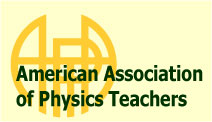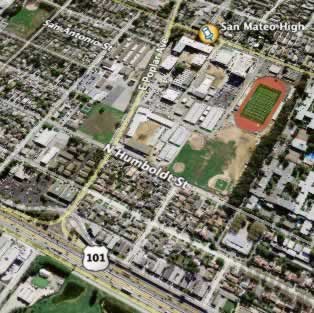|


|
The Spring 2006 Meeting
Northern California/Nevada Section AAPT
San Mateo High School
April 21–22 2006
Preliminary Program
|
50th Anniversary Meeting!
|
|
|
|
Friday Workshops
|
|
|
CASTLE Electricity (10 am – 4 pm)
Kim Freudenberg and Andria Erzberger will lead the popular CASTLE workshop in the
Career Center at San Mateo High School.
CASTLE (Capacitor-Aided System for Teaching and Learning Electricity)
is an electricity curriculum that leads students in self-guided experiments
to form models of current and voltage. Its priority is the development of qualitative reasoning skills,
so is available to all levels of math students.
Space will be limited so you must pre-register by sending $24 (if you pay)
or $48 (if your district pays)
to Andria Erzberger, 735 Chimalus, Palo Alto, CA, 94306.
Call Andi at (650) 494-3326 or email her at AndiErzberger@yahoo.com for more information.
Microwave Workshop (3–5 pm)
Bernard Cleyet will offer an afternoon workshop on microwave optics.
He will tailor the demonstrations and experiments according to the experience and desires of the participants.
Therefore, it is important that those interested contact him as soon as possible,
preferably by email at bernardcleyet@redshift.com or at (831) 771 2611.
He has at least two pair of wax prisms and a complete microwave system
(klystron transmitter and receiver plus accessories) to give away.
He also will, after the workshop, mail to those wishing, a DVD containing references,
construction hints, and articles on the demonstrations.
Vernier Updates (4–6 pm)
Upgrade/update your Vernier/TI software.
Learn about the new products from Vernier.
Come to the workshop in room C-114! Updates for Logger Pro, calculator OS, LabPro and CBL OS,
and trial versions of Logger Pro will be available.
You will also see new and hot products from Vernier
(if we're lucky this will include the très cool real-time spectrometer and wireless accelerometers).
Contact Clarence at
cbakken2001@yahoo.com to sign up for this workshop.
Deadline: April 18.
|
|
Friday Evening Social
|
|
|
 Room C-114, 2nd Floor, San Mateo High School Room C-114, 2nd Floor, San Mateo High School
Cheese, Crackers, and Sodas: 6:30 PM
Program: 7:30 PM
“Brunel—Engineer Extradinaire”
by Lewis C. Epstein
Lew Epstein has just returned from England
where he attended a conference celebrating
Isambard Kingdom Brunel, Victorian Engineer,
who designed bridges, docks, tunnels, railways and steamships.
He will share his experience and insights about this ingenious and creative engineer.
(The photo is Brunel, not Lew Epstein)
|
|
Saturday Program
Flex Theatre
|
|
|
7:45 Registration,
Coffee, Donuts, and other culinary
delights.
8:55 Welcome and Announcements
9:00 Show & Tell
Share your favorite demonstration or
teaching tip. Since new teachers and section
members will be at this meeting, you are
encouraged to dust off some of your oldies but
goodies. If you have handouts, please bring 75
copies. Time limit is 5 minutes per
person.
10:00 Invited Speaker:
The Physics of Brass Musical Instruments
Brian Holmes, San Jose State University, HornCabbage@aol.com
Brian Holmes received his doctorate from Boston University in 1980.
He has been a member of the Physics Department
of San Jose State University for fourteen years.
His interests include the physics of music and sports,
and physics education. A sought-after speaker,
his topics include musical acoustics and sports physics.
His talks are full of humor and energy, which complement the physical and musical insights he offers.
He enlivens his presentation with numerous demonstrations,
including building a trumpet from scratch.
He often plays an antique keyed bugle, a valve-less predecessor of
the modern French horn—and a length of garden hose.
Dr. Holmes performs regularly with the San Jose Symphony and Opera San Jose.
He has published many articles in physics publications
including Whoopee Cushion Physics, My Teacher is a Blowhard,
and Putting: How a golf ball and hole interact.
He has also published a number of original musical compositions and arrangements,
including 15 piano-vocal arrangements for the children's book,
I Have a Song to Sing (McElderry Books, Simon & Schuster).
11:00 Break
11:15 Invited Performance Bubble Magic
Tom Noddy, The Bubble Guy, Santa Cruz, CA, TNoddy@aol.com
After three appearances on The Tonight Show,
Tom was featured on the 'Best of the Year' Tonight Show segment.
In his 20-plus year career as America's Bubble Guy, he has appeared numerous times
on prime time television shows as well as nightclubs and universities.
Tom's work has been presented to 900 mathematicians at the
International Congress of Mathematics in Berlin, Germany.
He has been the featured performer for science centers Bubble Festivals
attracting up to 17,000 people in a single weekend.
He is as comfortable performing for pre-schoolers as he is when
entertaining audiences in the variete theatres of Germany, the Paris Opera,
Le Casino nightclub in Monte Carlo, corporate parties, trade shows,
or television throughout the world.
Tom has taken his uniquely warm and charming sense of wonder and delight
in soap bubbles to audiences around the world.
The bubbles are truly exquisite and Tom's lively humor and engaging sense of fun
leave his audiences both delighted and intrigued.
12:15 LUNCH: Chinese Buffet in the San Mateo Biotech Lab.
1:30–2:00 Raffle/Business Meeting:
Elections and reports from the officers.
50 Demos in 50 Minutes
To celebrate our associationís 50th anniversary,
Saturday morning will feature a special lecture demonstration presentation—50 demos
in 50 minutes! Presenters include Stephanie Finander, Paul Doherty,
Dean Baird, Don Rathjen, and Paul Robinson.
Contributed Papers: Room C-114, 2nd Floor
3:00 Classical Thermodynamics as Illustrated by Oxygen Condensation
Ted Foster, CSU, San Luis Obispo, tfoster@calpoly.edu
A chance observation of some liquid condensation
on the outside of a very cold can containing liquid nitrogen
prompted members of the Cal Poly physics faculty to investigate the nature of this phenomenon.
This presentation focuses on the nature of the condensation,
how we know the condensation is oxygen,
how to determine the outside temperature of the container,
what outside temperature is required to produce condensation,
and why the upper part of the can is free of condensation.
It will also be shown that the effect, when observed in a tall thin
tube over time as the nitrogen evaporates, is another illustration of “exponential decay.”
A list of other interesting effects will be mentioned, several of
which are related to the Leidenfrost effect.
3:20 Demonstrations With Teacher/Student Made Probes
Shengyan Zhang, Gustine High School, szhangmilbank@yahoo.com
Using simple tools and common materials such as glue gun, soldering gun,
diode, earphone, small speaker, metal wires (parts available from recycling old radios,
for example), my students made a variety of probes to measure temperature,
force, light, sound, current, conductivity, etc. One special value
of these experiments is that students learn about electronic circuits and how probes work.
Students also learned how to write simple programs in graphing calculators to run these student-made probes.
3:40 A Parachute Design Activity for Learning Scientific Process Skills
Frank Hicks, CSU, Sacramento, hicks@csus.edu
A guided-inquiry activity called "Prize Parachutes" introduces students
to the concepts of identification and control of experimental variables and is integrated with curriculum content (forces, motion, and energy). The activity has been successfully used with university undergraduates, middle school students, and K-12 administrators to teach scientific process skills. This talk will describe the activity, discuss the key principles of its design, and present sample assessments and student work.
4:00 Does successful prediction by a theory validate the assumed physical model?
Richard Kidd, Diablo Valley College, jmajr@mindspring.com
Although you know the answer to this question, many students do not,
and it is important for them to understand this point if they are to employ
critical thinking with respect to science. Seven historical examples are mentioned,
and a relevant and significant (but relatively unknown) 20th century controversy
between competing models is described.
|
|
Directions to San Mateo High
|
Hotels Nearby
|

Looking southwest across the Poplar Ave offramp from 101 south.
Good ol' Google Earth. Here is a “placemark”
(.kmz) file for you to download.
Link in Google maps.
From 101 North, take Peninsula Avenue exit;
go right over the 101 freeway and turn left the first signal (Humboldt Ave).
Continue on Humboldt to the signal and turn right onto Poplar Ave.
Turn right at the next signal onto Delaware Street.
From 101 South, take Poplar Avenue exit;
continue on Poplar past the first signal. Turn right at the next signal onto Delaware Street.
Once youíre on Delaware Street, turn into the driveway
just past the Performing Arts Center into the parking lot.
The Flex Theatre is just off the Quad at the center of campus.
|
These hotels that are within a few minutes of San Mateo High School.
I’ve tried to give some indication as to price via the number of $ signs.
|
$$ cheap, but that might be its only virtue
|
Holiday Inn San Mateo Airport
330 N. Bayshore Blvd., San Mateo, CA 94401
(650) 344-3249
|
|
$$
|
Wingate Inn San Francisco Airport South
480 North Bayshore Blvd
San Mateo, CA 94401
(650) 347-9990
|
|
$$$$ nice, but not cheap (nice bar with view of the bay)
|
Embassy Suites
150 Anza Blvd, Burlingame, CA
(650) 342-4600
|
|
$$$ (this is where the underwater bar scene with Gus Grissom from the movie
The Right Stuff was filmed!)
|
Best Western El Rancho Inn & Suites
1100 El Camino Real, Millbrae, CA 94030
(650) 588-8500
|
|
$$$
|
Hilton Garden Inn San Mateo
765 Airport Blvd., Burlingame, CA 94010
(650) 347-7800
|
|
$$$
|
Best Western, San Mateo
2940 South Norfolk Street, San Mateo, CA 94403
(650) 341-3300
|
|
Registration Fee
|
Upcoming Events
|
PTSOS News
|
What a
deal!
Your fee is waived for first-time attendees
and students! The rest of us pay only $15. A
bargain at twice the price!
|
Summer National AAPT Meeting, July 22–26, 2006, Syracuse, New York
Fall Meeting NCNAAPT, November 3–4 2006, Menlo High School
Winter National AAPT Meeting, January 5–10 2007, Seattle. Joint with AAS.
Spring Meeting NCNAAPT, Spring 2007, Stanford University
|
Attention New Physics
Teachers! PTSOS is here for you!
PTSOS is an NCNAAPT-sponsored project, funded by by a donation from the Karl Brown Foundation,
that helps physics teachers
in their vulnerable first years of teaching.
PTSOS is headed by Paul Robinson, Dean Baird, and Stephanie Finander.
The last of three day-long workshops was March 25th at San Mateo High. Other veteran teachers are being signed up to help out
small groups of local teachers through mentorships
and also to help run workshops.
|

Updated
September 2, 2006
|


 Room C-114, 2nd Floor, San Mateo High School
Room C-114, 2nd Floor, San Mateo High School